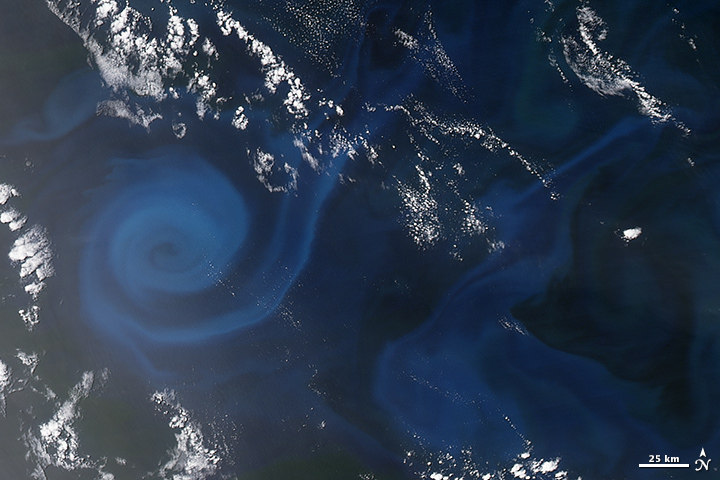File:Plankton swirl Jan 2015.jpg
Plankton_swirl_Jan_2015.jpg (720 × 480 pixels, file size: 161 KB, MIME type: image/jpeg)
<addthis />
Marine Food Chain
● Ocean Ecosystems -- http://en.wikipedia.org/wiki/Marine_ecosystem
Spiral of Plankton Visible from Earth Orbit | View from NASA Aqua Mission
While the northern latitudes are bathed in the dull colors and light of mid-winter, the waters of the southern hemisphere are alive with mid-summer blooms. The Moderate Resolution Imaging Spectroradiometer (MODIS) on NASA’s Aqua satellite acquired this natural-color satellite image of a plankton bloom as it appeared at 1:05 p.m. local time on December 30, 2013. The eddy is centered at roughly 40° South latitude and 120° East longitude, about 600 kilometers off the coast of Australia in the southeastern Indian Ocean.
Like land-based plants, phytoplankton require sunlight, water, and nutrients to grow. Sunlight is now abundant in the far southern latitudes, so nutrients are the limiting variable to phytoplankton growth. Open waters of the ocean can appear relatively barren compared to the nutrient-rich waters near the world’s coasts. In the case of the bloom above, the nutrients may have been supplied by the churning action of ocean currents.
As the close-up image shows, an eddy is outlined by a milky green phytoplankton bloom. Eddies are masses of water that typically spin off of larger currents and rotate in whirlpool-like fashion. They can stretch for hundreds of kilometers and last for months. As these water masses stir the ocean, they can draw nutrients up from the deep, fertilizing the surface waters to create blooms in the open ocean. Other times, they carry in nutrients spun off of other currents.
It is possible that the mesoscale eddy and plankton bloom shown above are related to the “great southern coccolithophore belt” (or the “great calcite belt.”) In late southern spring and summer (roughly November to March), satellite instruments detect an abundance of particulate inorganic carbon (PIC) in waters at high latitudes. The PIC is often due to calcium carbonate, which makes up the plate-like shells of microscopic plankton known as coccolithophores. The calcium carbonate gives the water a chalky aquamarine hue.
Image Credit: NASA Earth Observatory image by Jesse Allen and Robert Simmon, using data from the Land Atmosphere Near real-time Capability for EOS (LANCE)
Caption Credit: Michael Carlowicz, with image interpretation help from Norman Kuring, NASA Ocean Color Group
Release Date: January 9, 2014
+NASA's Earth Observatory #EarthScience
+NASA Goddard #NASA #Space #Satellite #Earth #Australia #Indian #Ocean #Phytoplankton #Biology #Life #Orbit #Aqua
http://www.greenpolicy360.net/w/Earth_Science_Research_from_Space
~ ~ ~ ~ ~ ~ ~ ~ ~ ~ ~
Tiny Blue Green
~
● Ocean's hidden world of plankton revealed in 'enormous database'
2015
Researchers have found that many of the plankton organisms, particularly the bacteria, are sensitive to temperature.
"It is temperature that determines what sort of communities of organisms we find. If we look at our data and we see what organisms are there, we can predict with 97% probability the temperature of the water they are living in.
"These organisms are most sensitive to temperature, more than anything else, and with changing temperatures as a result of climate change we are likely to see changes in this community."
The researchers say that this scientific analysis is just the beginning.
They are making their findings freely available to the scientific community to gain a better understanding of this vital but unseen underwater world.
"The amount of data we have released is already enormous; it is one of the largest databases of DNA available to the scientific community. But we've analysed perhaps 2% of the samples we have collected throughout the world - so there is a huge amount of work to do in the future to understand even more about the functioning of these marine ecosystems and the importance of that for the wellbeing of the planet.
File history
Click on a date/time to view the file as it appeared at that time.
| Date/Time | Thumbnail | Dimensions | User | Comment | |
|---|---|---|---|---|---|
| current | 20:11, 4 May 2015 |  | 720 × 480 (161 KB) | Siterunner (talk | contribs) | Category:Green Graphics |
You cannot overwrite this file.
File usage
The following 7 pages use this file:
- Biodiversity
- Citizen Science
- Earth360
- Earth Observations
- Earth Science
- Earth Science from Space
- Ecology Studies
- Ecoregions
- Environmental Full-cost Accounting
- Environmental Security
- Environmental Security, National Security
- EOS eco Operating System
- Externalities
- ISS
- Green Graphics
- Land Ethic
- Planet Citizen
- Planet Scientist
- Planet Citizens, Planet Scientists
- Sustainability
- Sustainability Policies
- Biogeosciences
- Climate Change
- Geophysics and Geochemistry
- Hydrology
- Natural Resources
- Oceans
- Ocean Ecosystem
- Ocean Science
- Ocean Sustainability
